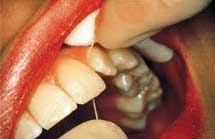 |
...für ein strahlendes lächeln | |||||||||||||||||||
 |
 |
|||||||||||||||||||
 |
|
|||||||||||||||||||
 |
|
|||||||||||||||||||
|
||||||||||||||||||||
Dental Care TipsDental care from the beginning It is very important that the dangerous plaque layer does not settle on the tooth surface to maintain the health of the teeth. After the breakthrough of the first baby tooth dental care should be started. The baby teeth should be brushed with child's toothbrush with the help of the parents. As soon as the child is able to rinse, usually from the age of 4 years, the teeth should be cleaned regularly with a toothbrush and toothpaste. After the breakthrough of the permanent teeth at the age of 6 to 12 years, care must be taken to ensure that no plaque builds-up on the young tooth hard substance. The right brushing technique with pictures 1. Brush teeth from the gum to the crown! 2. Now the insides of the incisors 3. Brush back and forth on the chewing surfaces of molars 4. Now the inside of the molars from the gums to the tooth crown
What you can do at home? To prevent caries you can use fluorides in different ways. We all know fluorides from daily brushing. Fluoride-containing toothpastes contain fluorides in a concentration of0.1% -0.15%. The use of fluoride-containing toothpastes shows caries growth reduction by 20% - 40%. Fluorides are found in toothpastes in various compositions. The common toothpastes contain sodium fluorophosphate, amine fluoride or sodium fluoride. Tooth Gel The individual tray allows accurate dosage of the fluoride containing gel for single use per day. The gel coated tray is slipped over the teeth for a short time.
|






